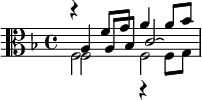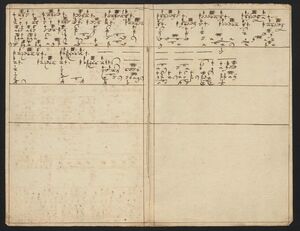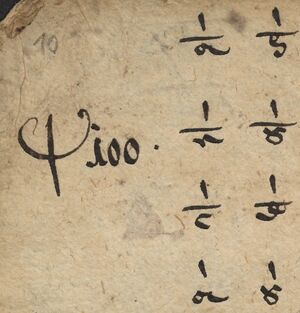Lynar Tablatures
The Lynar tablatures are a collection of manuscripts that are currently held in the Staatsbibliothek, Berlin. Many of the manuscripts are now available on the internet.
History[1]
The first Lynar tablatures that were known to musicologists were the A 1 and A 2 manuscripts. These two manuscripts had copies made of them in the middle of the 19th century. Later in the 19th century both manuscripts went missing (In the 1894 edition of keyboard works of Sweelinck, Max Seiffert could only rely on the 1841 copy). However, the "A" manuscripts were fortunately found in 1920, and around this time the 11 manuscripts in tablature notation were discovered by Rochus Friedrich zu Lynar. All 13 manuscripts were collected and stored in the Spreewald museum in Lübbenau-Lehde. In 1933[2] Max Seiffert inspected the manuscripts and assigned the shelfmarks starting with A (referring to staff notation) and B (tablature notation). The description penciled on the front of each manuscript is written by Seiffert.
In 1956, the manuscripts were moved to the Staadtsbibliothek, Berlin, retaining their previous shelfmarks.
Description
According to the Berlin Staatsbibliothek website, the shelfmark for the manuscripts is stylized Ms. Lynar A 1, Ms. Lynar B 2, etc.
Contents
You can help pipe-organ.wiki!
Can you...
- Complete the tables of pieces for the "A" tablatures?
- Check the spelling of the headers of pieces in the manuscripts?
- Read the cursive handwriting on the cover of each manuscript?
Lynar A 1[3][4]
Lynar A 2[5][6]
Lynar B 1[7][8]
| No. | Title | notes |
|---|---|---|
| 1 | Fantasia Auff die manier von ein Echo. M. J. P. S. | Jan Pieterszoon Sweelinck |
| 2 | Puer natusin Bethlehem a Paulus Sivert | Paul Siefert |
| 3 | Nun komm der Heÿden Heÿlandt | Paul Siefert? |
| 4 | Nun Lobe meine Seele den Herren Auff 2 Clavir D. H. | Düben? |
| 5 | Wo Gott der Herr nicht beÿ unß Held auff 2 Clavir Andræ Duben | Andreas Düben |
| 6 | Allein Gott inn der Höh seÿ Ehr. M. J. P. | Jan Pieterszoon Sweelinck |
| 7 | Variatio Bicinium M. J. P. | Jan Pieterszoon Sweelinck |
| 8 | Variatio coral in Tenor M. J. P. | Jan Pieterszoon Sweelinck |
| 9 | Variatio coral in cantu 4 Vocum M. J. P. | Jan Pieterszoon Sweelinck |
| 10 | Variatio Choral in Cantu auff 2 Clavier A. Duben | Andreas Düben |
| 11 | Variatio choral in Basso A. D. | Andreas Düben |
| 12 | Variatio Choral in Bass M. Duben | Martin Düben |
| 13 | Variatio Choral in Baß 3 vocum | |
| 14 | Varatio | |
| 15 | Variatio Choral in Tenore 3 vocum P Hassen | Petrus Hasse |
| 16 | Variatio 3 Vocum Choral in Basso P. Hass | Petrus Hasse |
| 17 | Var. 12 G. S. | Gottfried Scheidt |
| 18 | Var. Choral in Cantu auff 2 Clav. G. S. | Gottfried Scheidt |
| 19 | 4 vocum | |
| 20 | Variatio Zum Alt vndt Tenor muße nur Stimmen von 4 Fuß gezogen werden | |
| 21 | Variatio Choral in Cantu auf 2 Clav. | |
| 22 | Variatio Choral in Tenore | |
| 23 | Allein Gott in der Höh seÿ EHR: S. S. | Samuel Scheidt |
| 24 | Allein Gott â 3 Vocum Choral in Bass W. Karges | Wilhelm Karges |
| 25 | Erstanden ist der Heilige Christ M. D. Simpel - Auff 2. Clavir - Choral in Cantu auff 2. Clavier. - Coral in Basso 3. Voc: | Martin Düben |
Lynar B 2[9][10]
Description
Lynar B 2 is a folio volume over 30 pages.
It doesn't contain any clues as to its origin, copyist, or date. Some theories include that it was compiled in North Germany around 1620-1630 or by Melchior Schildt while he was in Copenhagen around 1626-1629. However, different hands can be identified as having copied different pieces in the manuscript, so it may have been compiled over a longer period of time.
The tablature contains only fantasias and chorale/psalm settings. Of the 17 pieces contained within, two are headed by initials which give a hint to the composer. Of the rest, three more can be identified based on concordances with other manuscripts. The composers of these five works are Jan Pieterszoon Sweelinck, Melchior Schildt and Heinrich Scheidemann. The rest of these pieces remain anonymous, but can be attributed to various composers on stylistic grounds.
Works
| No. | Title | notes | Incipit |
|---|---|---|---|
| 1 | [Fanta]sia [mit B]indungen | Jan Pieterszoon Sweelinck | |
| 2 | Fantasia A 4 | Anonymus: Jan Pieterszoon Sweelinck | |
| 3 | fantasia primi Toni A 4 | Nun komm der Heiden Heiland |  |
| 4 | ach Gott vom him: mel sieh darein. | Heinrich Scheidemann? |  |
| 5 | Herr Christ der Einig Gottes Sohn… M.S | Melchior Schildt | |
| 6 | Wie schön leucht unß der Morgenstern | 1 variation 2 variatio  3 variatio  4 variatio  5 variatio  | |
| 7 | Nun freut euch lieben Christen gmein | 1 variatio 2 variatio  3 variatio 4 variatio  5 variatio  | |
| 8 | psalm 116 J. P. | Jan Pieterszoon Sweelinck | |
| 9 | O Lux Beata Trinitas: |  | |
| 10 | psalm 60 A 2 | Anonymus: Jan Pieterszoon Sweelinck | |
| 11 | O Gott du unser Vater bist | Anonymus: Jan Pieterszoon Sweelinck | 1 variatio 2 variatio 3 variatio  |
| 12 | P 23 Mein hütter Undt mein hirtt | Anonymus: Jan Pieterszoon Sweelinck |  |
| 13 | die 10 Gebott Gottes | Jan Pieterszoon Sweelinck | 1 variatio 2 variatio  3 variatio  4 variatio  |
| 14 | Es spricht den unweisen Mundt woll | Heinrich Scheidemann | |
| 15 | Fuga Cromatico ex D.la.sol.re. | ||
| 16 | Fantasia A. 2: 3: et 4 Vocum | Anonymus: Jan Pieterszoon Sweelinck | |
| 17 | Fantasia Super ut re mi fa.sol.la. A. 3. Vocum |
After the publishing of 8 more works in Lynar B 2 by Pieter Dirksen in 1991, two works remain unpublished. The Fuga Cromatico and Fantasia Super ut re mi fa.sol.la. were described as "a brief composition employing imitation and simple chromatic lines" and "a pedantic, three-part hexachordal settings, in which the sogetto appears in the bass thirteen times in exactly the same form, constantly alternating between entries on c and G" respectively.
The setting of O God die onse Vader bist can for now be securely attributed to Sweelinck on the basis of the cantus firmus being a Dutch psalm in addition to stylistic features. Similarly, the setting of Psalm 23 can also be attributed to him, especially based on the similarities to Sweelinck's composition on Psalm 116 (which can be found in other manuscripts).
Confusingly, the manuscript contains a piece titled "fantasia primi / Toni A 4" which is neither a fantasia nor in the first tone. In fact, it is a chorale setting of Nun komm, der Heiden Heiland.

It is possible that this heading was written by a different copyist before this work was written at a later date. In any case, this work only uses the first (identical with the last) line of the chorale (which means that this work could be classified as a choral ricercare or choral fugue), and the contrapuntal writing is strikingly plain and schematic. In fact, this piece has been described as containing a "peculiar monothematic compositional technique, which is probably unparalleled in the surviving corpus of seventeenth century choral settings."
According to Pieter Dirksen, the chorale fantasia Ach Gott, vom Himmel sieh' darein stands apart from the other works in Lynar B 2, as it transmits a chorale fantasia in the fully mature form. This piece can be attributed to Heinrich Scheidemann based on a few factors, including the absence of so-called "simple echo combinations". It can be dated from around 1640-1650.
The setting of O Lux beata Trinitas appears to be a result of the early Sweelinck school based on some sixteenth-note figurations that can be found within it. However, it can not be found to be similar to any single composer on stylistic grounds. The cantus firmus appears in the tenor voice completely un-ornamented in long notes. This arrangement suggests that it can be played in pedal, but the voice rises up to f' which would require a 4-foot stop to be used.
Lynar B 3[11][12]
This manuscript's pages are numbered in a way that is slightly similar to the recto and verso method of numbering folios, in which each group of two pages that are visible when opened are counted together. In other words, 2v-3r is labeled 2. A piece which is on four pages (in other words, 2v-4r) is labeled 2-3. The numbering on the left side and right side of each group of pages are not idential, the numbering on the left side is counted here.
| No. | Title | notes |
|---|---|---|
| 1 | [fragment] | Recto folio only |
| 1 | Praeludium [fragment] | Recto folio only |
| 2 | Praludium | |
| 3 | Praeludium | |
| 4 | Praludium | |
| 5 | Praludium / H S M | H S M = Heinrich Scheidemann |
| 6 | Vater unser / in Himmel / reich. / MW. C. B. M. // 2 Variation // 3 | 3 verses. Final verse is succeeded by "Verte [sic.]" |
| 7-9 | Fantasia / J. P. [?] | |
| 10 | Fantasia. / 6 toni. | |
| 11 | Praludium / pedaliter | |
| 11 | Praeludium | |
| 12 | Herr Christ / der einige Gott / es dahin [?] | |
| 13 | Praludium | |
| 14 | Praludium | |
| 15 | Praludium | |
| 16 | Praludium / secundi Toni / Auf 2 Clavir / und pedahll. | Succeeded by "finis" |
| 17-19 | Fantasia | Succeeded by "finis". |
| 20-21 | [20] Vater unser / im himmell / reich Corahll / im Bas. // [21] 2 Vers auf // 2 ine[?] Clavier / und pedahll | 2 verses. 1st verse succeeded by "verte". 2nd verse succeeded by "finis" |
| 22-23 | O Mensch be= / weine deine / sünde gros auf. / 2 Clavier der Co= / rahll gecollorirett / M. W. C. B. M. | succeeded by "In 5 April / Ao 1628 / Sequitur" |
| (blank pages) | ||
| 24 | Praeludium / pedaliter / David Abel. | |
| 25 | Praludium / David Abels. | |
| 26 | Fuga | |
| 27 | Ricercar / primi Toni | |
| 28-30 | Ricercar / primi Toni / ex G. B. moll | |
| 31 | Praludium / Ex E. Vel / a. pedaliter / M. D. O. | |
| 32 | Praambulum / pedaliter / M. D. O. | |
| 33 | Praambulum / pedaliter | |
| 34 | Praambulum / pedaliter | |
| 34 | Praludium / pedaliter | |
| 35 | Praambulum / pedaliter / P. H. | |
| 36 | Praludium / pedaliter / M. F. P. S. W. | |
| 37 | Praludium / pedaliter | |
| 38 | Praludium / M. D. O | Fragment? |
| 39 | Praludium / pedaliter | |
| 39 | Praludium | |
| 39 | Praeludium / pedaliter | |
| 39 | Praeludium / pedaliter | |
| 40 | Praludium / pedaliter | Verso folio. Fragment |
Lynar B 4[13][14]
This manuscript contains four pieces:
- "In dir hab / ich gehoffet / Herr / auf 2 Clavier / manualiter" starting on page 1
- Illegible, maybe "Jesus Christus / unser heÿlantt / auf 2 Clavir / pedaliter" on page 4
- "Fantasia / M. S[?]. P." on page 10
- "Fantasia / A. 3 Vocum / Transpon: per 4ton" starting on page 14 and ending on the page 16-17 opening.
The page numbers (instead of folios) have been penciled in by a librarian.
Lynar B 5[15][16]

This manuscript contains one piece, a fragment of a Chorale Fantasia Durch Adams Fall ist ganz verderbt auff 3 clavier by Jakob Praetorius. The piece is neatly written in five voices, suggesting that the top voice is to be played on Rückpositiv, the second on Brustwerk, the third and fourth on Organum, and the bottom in Pedal[17].
Lynar B 6[18][19]
Mus. ms. Lynar b 6 contains a manualiter Toccata auf 2 clavir by Heinrich Scheidemann on 10 pages.

Lynar B 7[20][21]
Ms. Lynar B 7 consists of variations on the Genevan psalms, some one verse and some several. The header of each piece is stylized by a three-pronged symbol (roughly ⟒) followed by the number of the psalm. Some verses are also marked "3 voci" or "Corall in tenor" for example.
Lynar B 8[22][23]
This manuscript contains two pieces, "Ich ruff zu / dir herr / Jesu Christ / auff 2. clavier" and "Alio modo / auff 2. und 3. / Clavir, und auff der / Pedal zu gebrauf [?] / Anton Neünhaber." These are thought to be two verses of the same piece by Andreas Neunhaber[24]. The second piece is in five voices and has detailed manual change indications written into the tablature.
Lynar B 9[25][26]
Lynar B 9 contains two preludes on two pages. The title page lists the keys/tonality "A cis" and "F a".
Lynar B 10[27][28]
This manuscript contains one [fragmented?] piece, anonymous Sei nun wieder zufrieden a 3. The composition ends after the first system on the third page, the final symbol is a cut time signature.
Lynar C 1[29][30][31]
Lynar C 1 (also referred to as B 11) contains anonymous simple settings of the genevan psalms for keyboard.
References
- ↑ Schnieders, Hans, "Fingersätze für Tasteninstrumente aus dem Umfeld Sweelincks und seiner Schüler". [1], accessed 15 September, 2023. 2.15 Lynar A1
- ↑ Seiffert, Max (editor), Sweelinck: Werken voor Orgel en Clavecimbel. Amsterdam: G. Alsbach & Co., 1942. xlvi
- ↑ [2] accessed 18 July, 2023.
- ↑ RISM1001079614
- ↑ [3] accessed 18 July, 2023.
- ↑ RISM1001079620
- ↑ Beckmann, K., 2009. "Blütezeit und Verfall", 1. Auflage. ed, "Die Norddeutsche Schule: Orgelmusik im protestantischen Norddeutschland zwischen 1517 und 1755". Schott, Mainz.
- ↑ RISM1001048774
- ↑ 9.0 9.1 9.2 9.3 9.4 9.5 9.6 9.7 9.8 Dirksen, P., "Eight Chorale Settings by Jan P. Sweelinck and his School", 1991, Vereniging voor Nederlandse Muziekgeschiedenis, Utrecht
- ↑ RISM466000013
- ↑ [4] (Mirrored IMSLP554336) accessed 17 July, 2023.
- ↑ RISM466000011
- ↑ [5] accessed 18 July, 2023.
- ↑ RISM1001048776
- ↑ [6] accessed 17 July, 2023.
- ↑ RISM1001048780
- ↑ Brieg, Werner (editor). Jacob Praetorius: Choralbearbeitunen für Orgel. Kassel: Bärenreiter, 1974.
- ↑ [7] accessed 18 July, 2023.
- ↑ RISM1001048781
- ↑ [8] accessed 18 July, 2023.
- ↑ RISM1001048782
- ↑ [9] accessed 18 July, 2023.
- ↑ RISM1001048783
- ↑ Beckmann, K. (editor). 3 Choralbearbeitunten von Anton Neunhaber und Ewald Hintz. Wiesbaden: Breitkopf & Härtel, 1974.
- ↑ [10] accessed 18 July, 2023.
- ↑ RISM1001048784
- ↑ [11] accessed 18 July, 2023.
- ↑ RISM1001048785
- ↑ Seiffert, Max (editor), Sweelinck: Werken voor Orgel en Clavecimbel. Amsterdam: G. Alsbach & Co., 1942. xlvi
- ↑ Deutsches Musikgeschichtliches Archiv Kassel: Mitteilungen und Katalog der Filmsammlung Nr. 1. Kassel: Barenreiter, 1955. 23. [12] accessed 15 September, 2023.
- ↑ Schnieders, Hans, "Fingersätze für Tasteninstrumente aus dem Umfeld Sweelincks und seiner Schüler". [13], accessed 15 September, 2023.